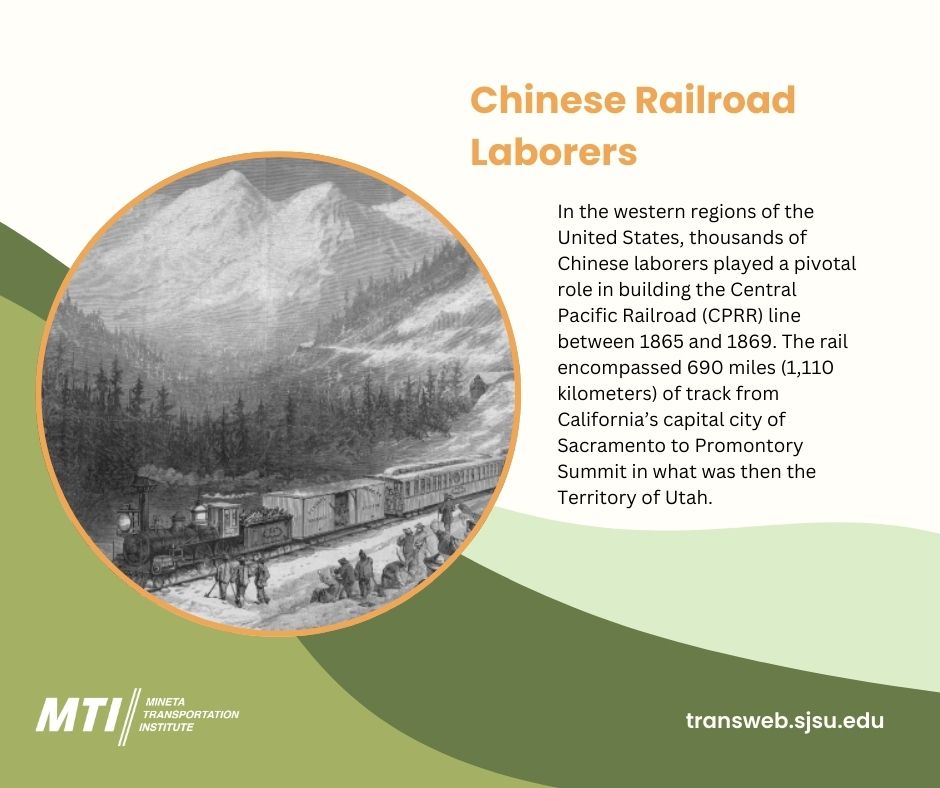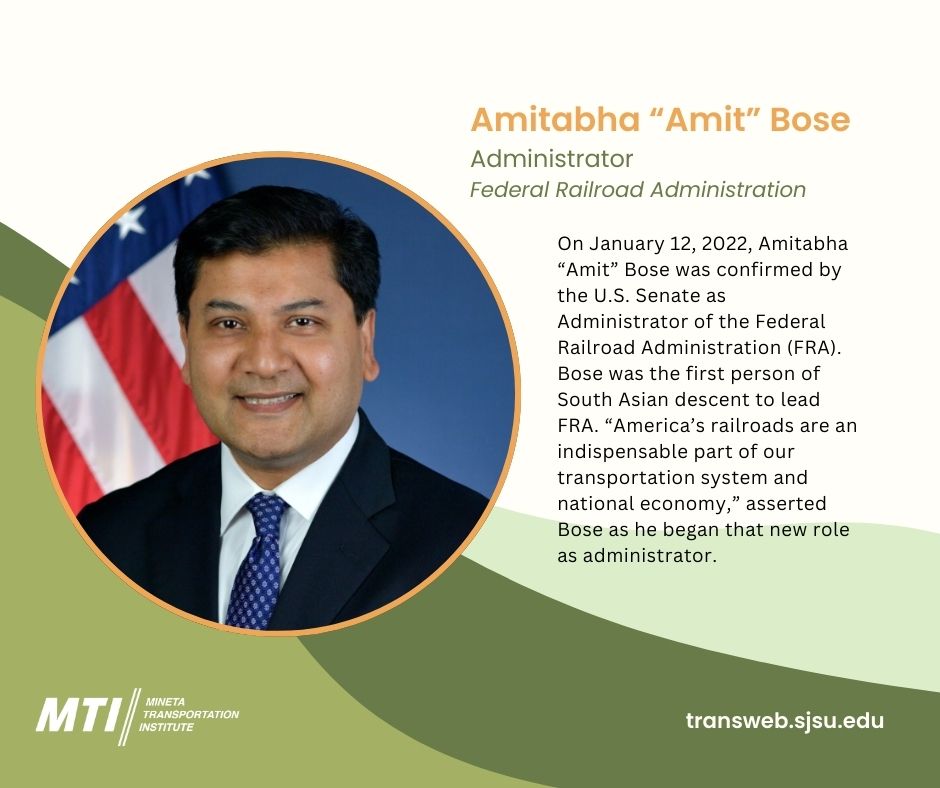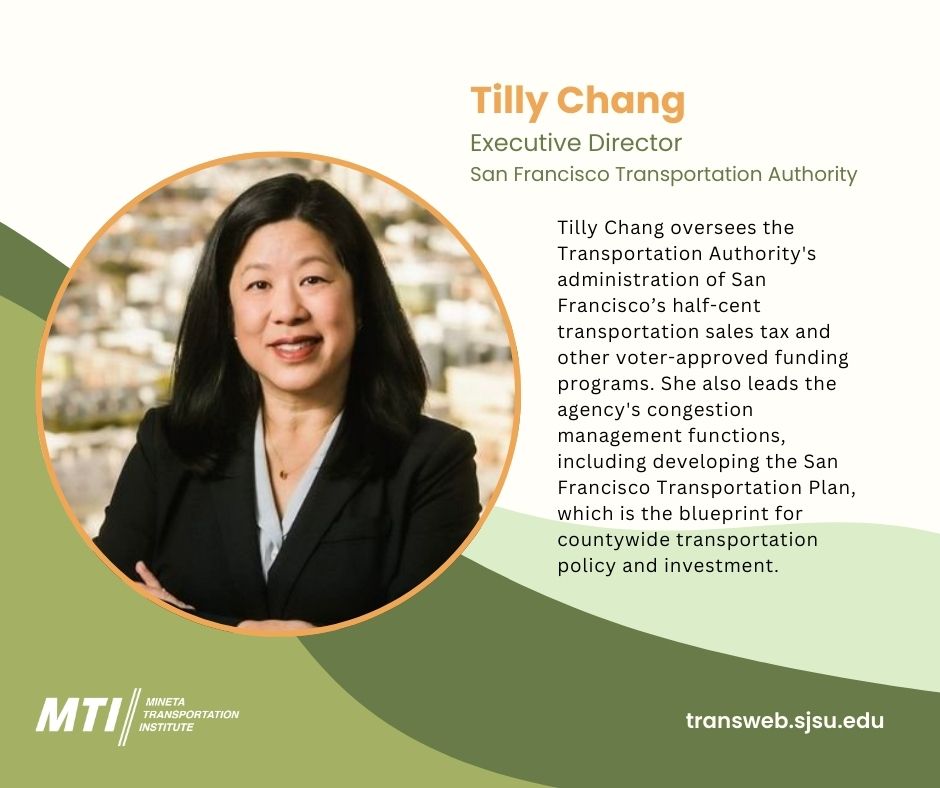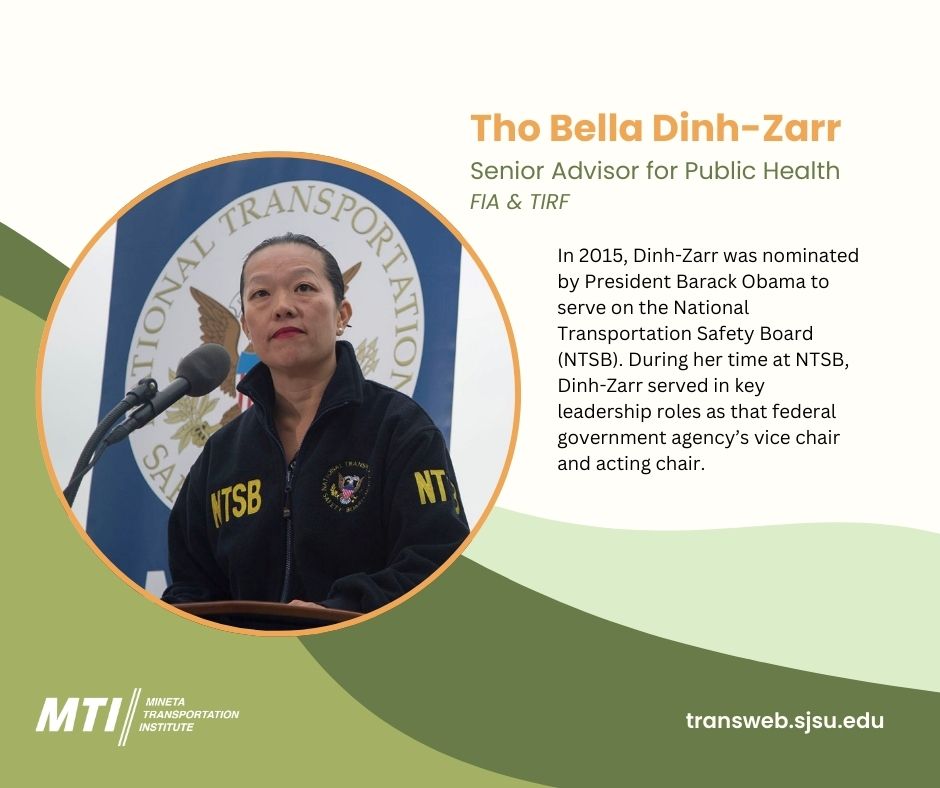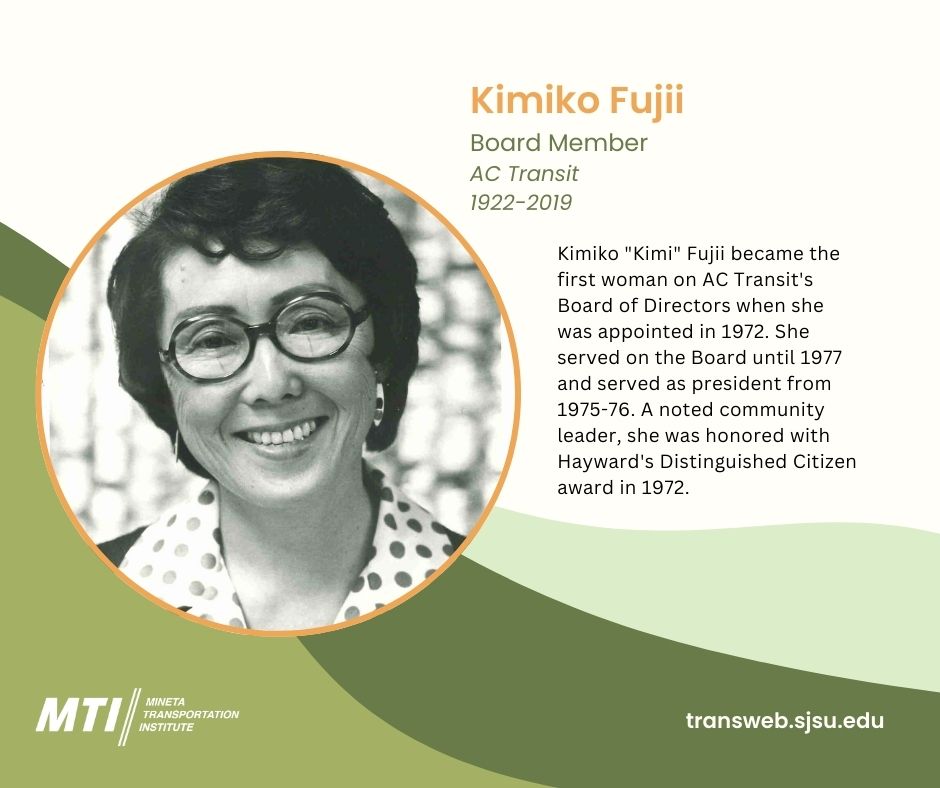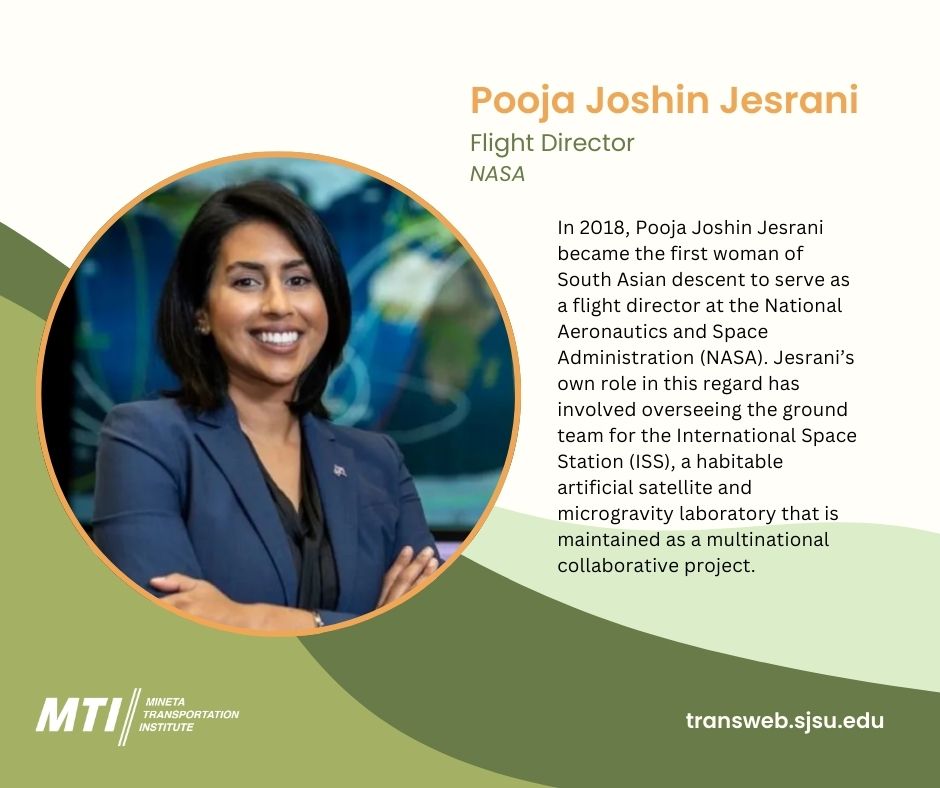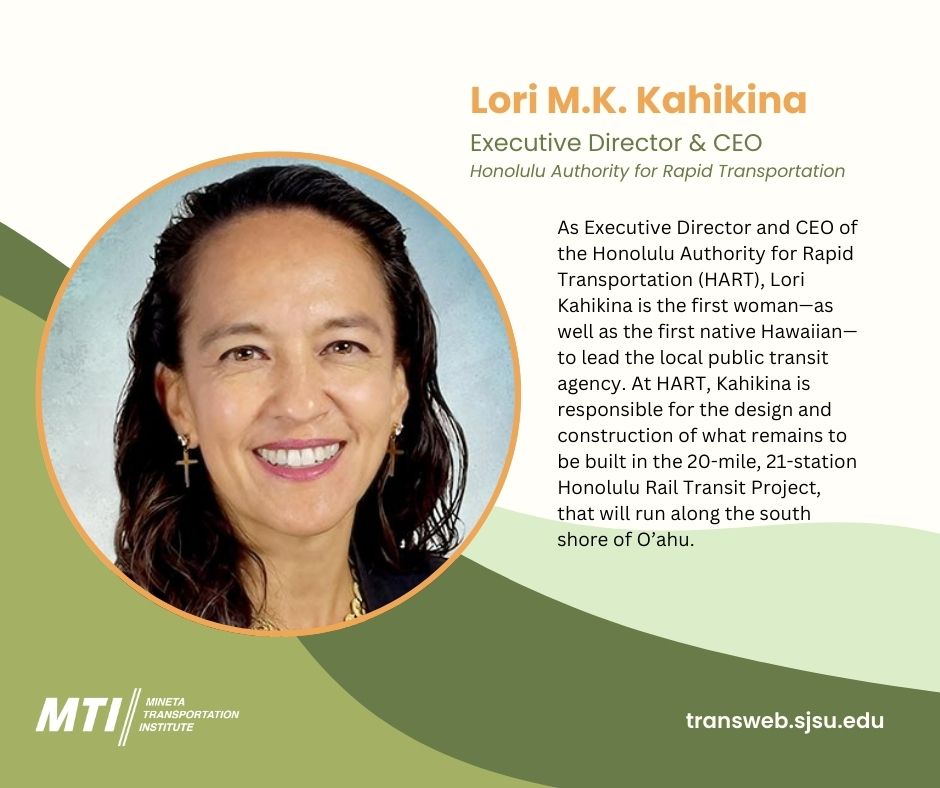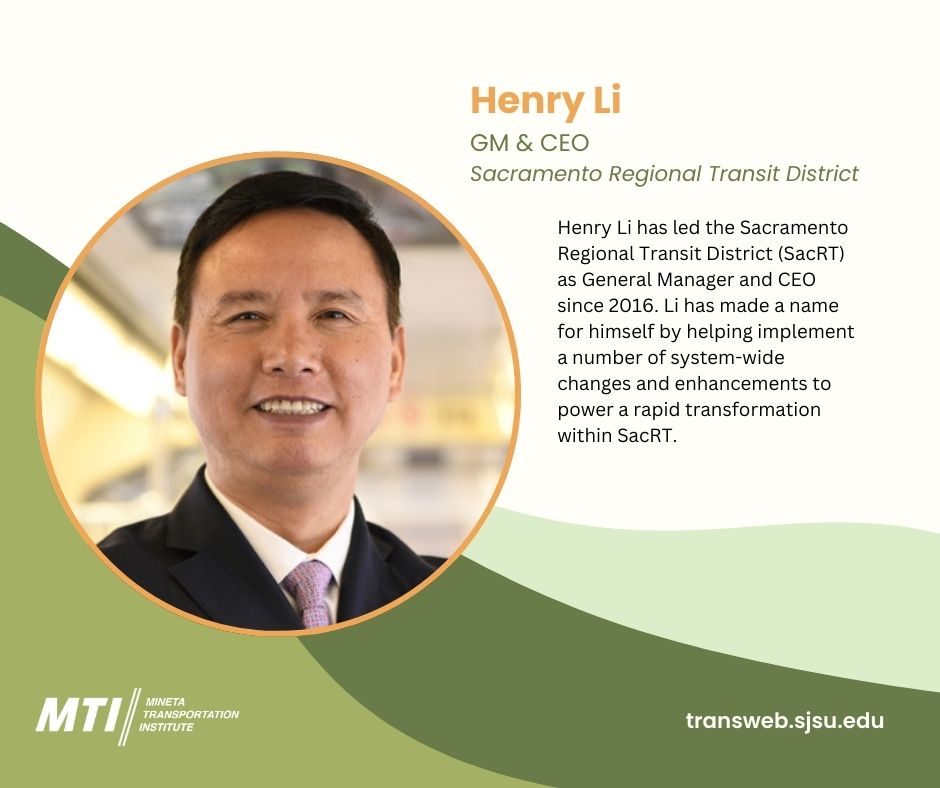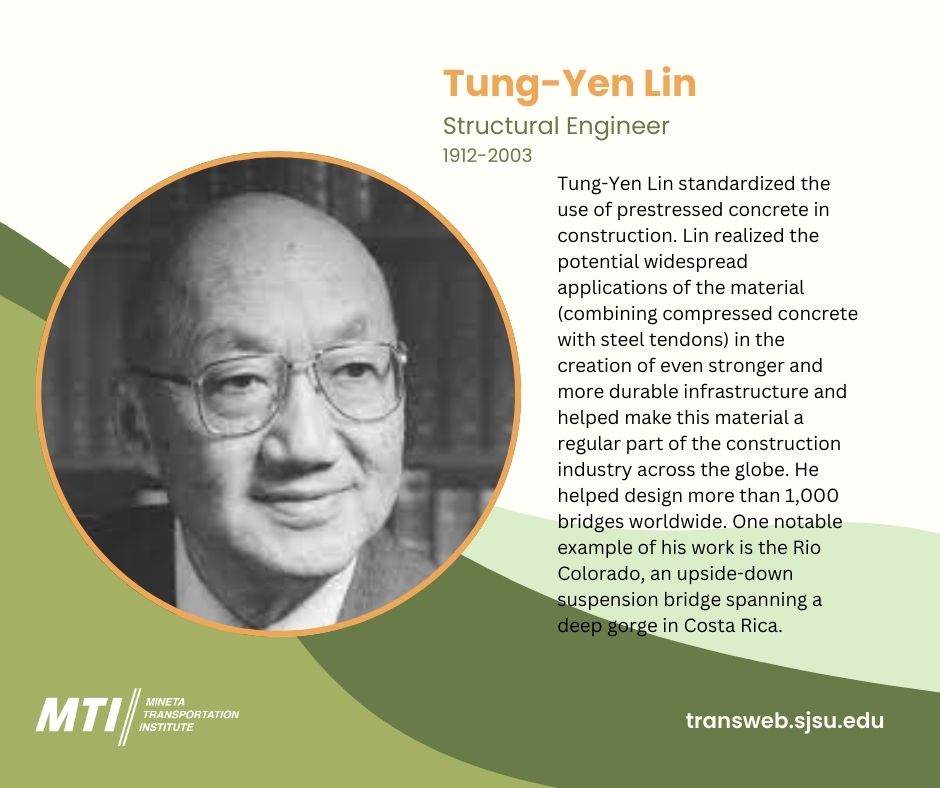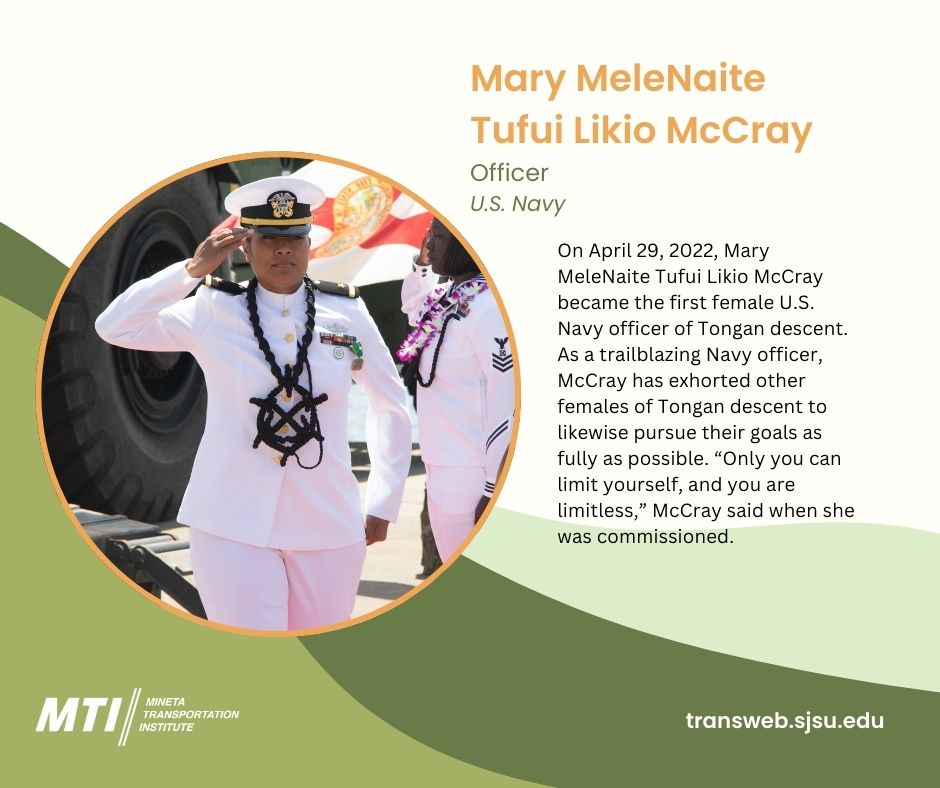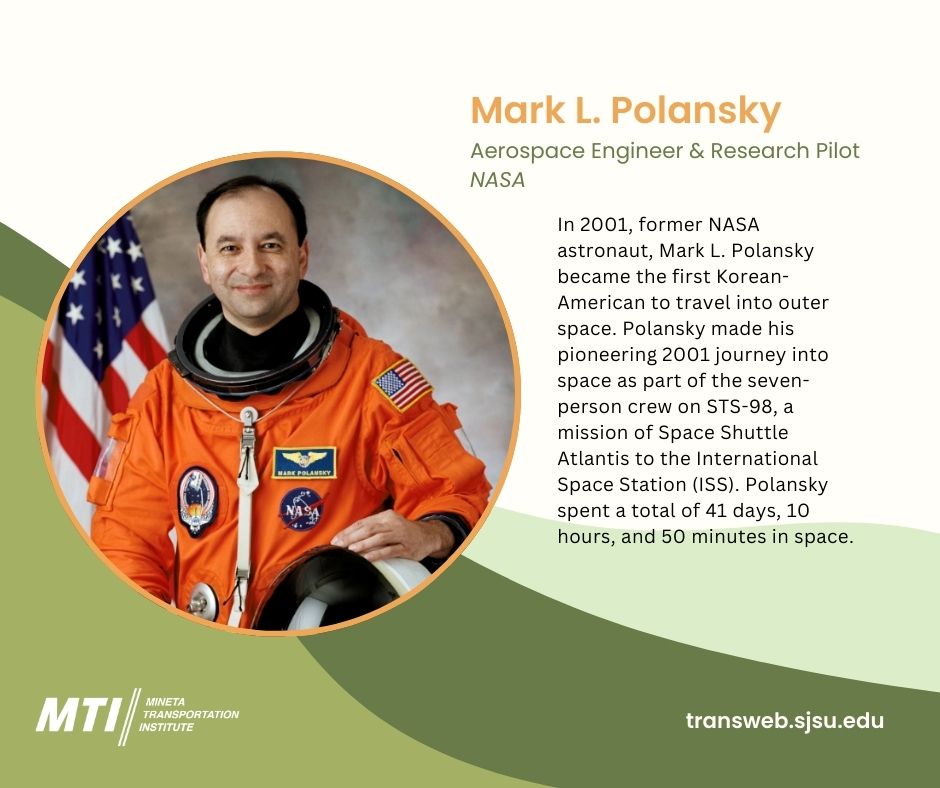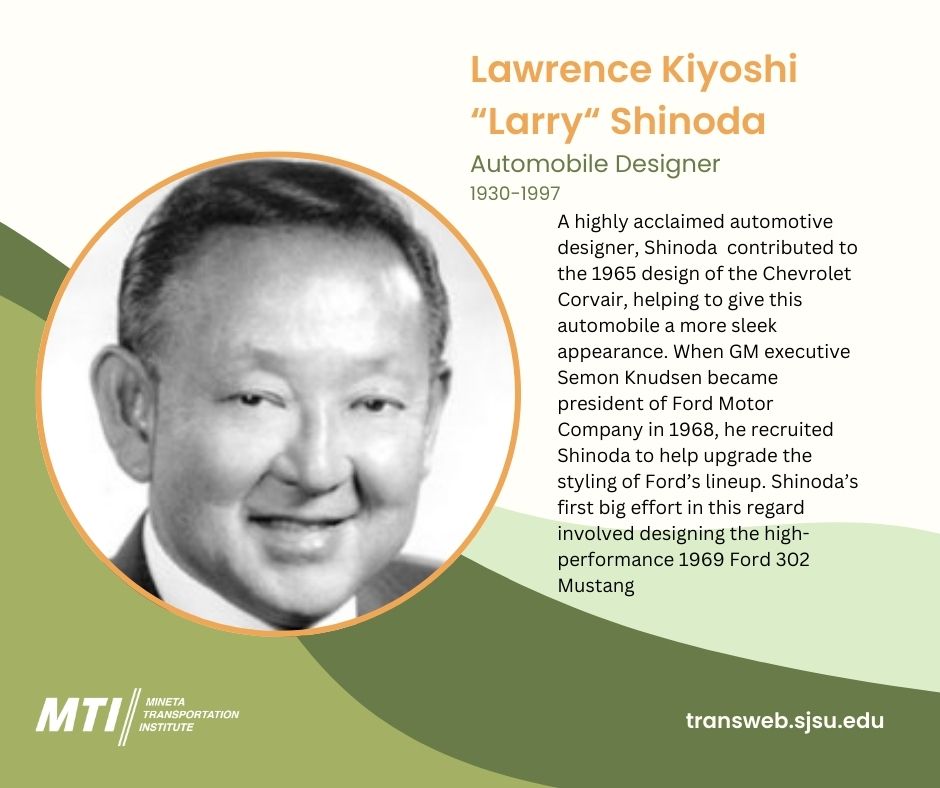- 408-924-7560
- mineta-institute@sjsu.edu
- Donate
MTI Celebrates Asian American and Pacific Islander Heritage Month (May 2024)
We’re celebrating Asian American Pacific Islander (AAPI) Heritage Month! This broad term encompasses the more than 24 million Asian Americans who trace their heritage to more than 20 countries, each with its own unique languages and cultures.
Did you know that nearly half of Asian people in the U.S. live in the West (45%)? Many thriving Asian American communities can be found in New York, Texas, New Jersey, and Washington, but California is home to the most Asian American people in the country. In CA at MTI, we are no stranger to the influence of AAPI cultures and trailblazers, including our namesake, San Jose native Japanese-American former Secretary of Transportation Norman Y. Mineta.
AAPI people have made such an immeasurable impact on our nation’s history, including in transportation. Get started celebrating AAPI history this month by learning more about Asian cultures and contributions. The Smithsonian’s Asian Pacific American History, Art, & Culture in 101 Objects is an excellent place to start. Then, be sure to come back to check out our series on the history of AAPI folks in transportation and features on AAPI transportation leaders of today!
|
|
Chinese Railroad LaborersOne of the greatest engineering feats in American history would not have been possible without the hard work of Chinese immigrants. The 690-mile Central Pacific Railroad (CPRR), the western section of the transcontinental railroad, was built from 1865-1869 and ran from Sacramento, CA, to Promontory Summit in what was then the Territory of Utah and native land of several indigenous groups, including the Ute. Many of the laborers risked and even lost their lives in the building of the CPRR. They were paid an average of 30% less than their white counterparts, were often segregated in work camps, and faced intense prejudice. This prejudice culminated in the Chinese Exclusion Act in 1882, which was the first significant law restricting immigration into the United States. According to the National Parks Service, some historians have called the Chinese railroad workers “Silent Spikes,” “because none of their correspondence or diaries are known to still exist in the United States or in China, making it difficult to tell the stories of individuals” and because they were “systemically anonymized.” Still, there is ample evidence about a group of these laborers who held a strike to demand better working conditions and thus reflected the kind of organization and bravery that would be seen in future labor movements. The approximately 12,000 Chinese laborers who played a pivotal role in the building of CPRR is just one example of the valuable contributions of AAPI people to the betterment of transportation and our nation as a whole. |
|
|
Amitabha “Amit” Bose Amitabha “Amit” Bose is the first South Asian person to be confirmed as Administrator of the Federal Railroad Administration (FRA). In this role, Bose leads the safety regulatory oversight of our nation’s more than 800 freight and passenger railroads and is involved in national rail policy and planning and environmental activities. Bose previously worked at engineering and architectural firm HNTB. He also served in a variety of roles at the U.S. Department of Transportation (DOT) during the Obama-Biden Administration—first as FRA’s Director of Governmental Affairs, then Senior Advisor, Chief Counsel, and eventually Deputy Administrator. Before that, Bose served as Director for the New Jersey Department of Transportation and Director of Federal Government Relations at New Jersey Transit. As FRA Administrator Bose said, “America’s railroads are an indispensable part of our transportation system and national economy.”
|
|
|
Tilly ChangTilly Chang has been a part of San Francisco County Transportation Authority leadership for more than two decades. As Executive Director, she oversees the Transportation Authority's administration of San Francisco’s half-cent transportation sales tax and other voter-approved funding programs and leads the agency's congestion management. This Asian American Pacific Islander month, MTI is highlighting AAPI transportation change-makers like Tilly Chang A graduate of UC Berkeley and M.I.T, Chang is also extensively involved in supporting and advocating for the betterment of her community and the industry through leadership roles. She is Chair of the Self-Help Counties Coalition and Vice-Chair of the Transbay Joint Powers Authority's Peninsula Rail Program Executive Steering Committee. She also serves on the boards of the Intelligent Transportation Society of America, UC CONNECT Advisory Committee, and Self-Help for the Elderly. MTI previously featured Tilly Chang in our Women’s History Month Trailblazer Tuesday series. In this webinar, her advice for young professionals and aspiring leaders included, “It’s important to understand the stories of women who have come before us and of leaders who have served before us…Know your history and try to learn from the examples who came before. Follow your authentic self and your passion. Do so unapologetically.” https://www.youtube.com/watch?v=VYmMBqa6aRY
|
|
|
Tho Bella Dinh-Zarr, MPH In her office, Tho Bella Dinh-Zarr keeps the designation letter appointing her vice chair of the National Transportation Safety Board, signed by President Barack Obama. She also has keepsakes from her studies in Chile and Texas and a paper boat from Vietnam. “I brought back a paper ship and a paper bridge, a replica of the Japanese Friendship Bridge, or the Covered Bridge, not far from where my family lives. I try to have all modes of transportation around so it doesn’t look like I have a favorite,” she told a NYT journalist during her time in Washington. MTI is celebrating AAPI leaders by highlighting their contributions to transportation for AAPI History Month. Dinh-Zarr, who has called herself “Vietnamese-Chinese-Texan-American,” served in key leadership roles at the National Transportation Safety Board (NTSB). She earned her PhD from the University of Texas School of Public Health. These days, Dinh-Zarr is a leader at the FIA (Fédération Internationale de l'Automobile) Foundation for the Automobile and Society, a charity foundation advancing transportation safety, continuing to make transportation safer for all.
|
|
|
Kimiko FujiiKimiko "Kimi" Fujii became the first woman on AC Transit's Board of Directors when she was appointed in 1972. She served on the Board until 1977 and as president from 1975-76.Born in Hayward, CA to Japanese immigrants in 1922, Fujii recalled experiencing prejudice and being faced with the “model minority” stereotype in high school. Still, she persevered to attend UC Berkeley until her family was forcibly removed from their home, along with more than 100 other Japanese American families from Hayward, to Tanforan Racetrack in San Bruno and later to Topaz Internment Center in Utah. With support from the Quaker organization known as the American Friends Service Committee, Fujii was able to leave the internment camp and take university courses again. Eventually, she returned to Hayward to help run her family’s nursery. There, she became increasingly involved in community leadership, including as a delegate at the 1964 Democratic National Convention. In 1972, Fujii took her first political office as the first woman to ever serve on the Alameda County Transit District Board. An admired industry and community leader, her hometown honored her with the Hayward Distinguished Citizen award.
|
|
|
Pooja Joshin JesraniIn 2018, Pooja Joshin Jesrani became the first woman of South Asian descent to serve as a flight director at the National Aeronautics and Space Administration (NASA). Jesrani previously held positions within the flight control team, including capsule communication with astronauts in space and the management of life support systems. The 15th female flight director in history, Jesrani is involved in overseeing the ground team for the International Space Station (ISS). Jesrani said of her leadership role, “I went to Mexico City a few years back, and I saw a quote on a wall that said, ‘I am, because we are.’ I really resonated with that because I am who I am—I am a Flight Director—because we are. We as a team, we all sit here together. We all do this mission together.” |
|
|
Lori M.K. KahikinaAs Executive Director and CEO of the Honolulu Authority for Rapid Transportation (HART), Lori Kahikina is the first woman—as well as the first native Hawaiian—to lead the local public transit agency. At HART, Kahikina is responsible for the design and construction of what remains to be built of the 20-mile, 21-station Honolulu Rail Transit Project, that will run along the south shore of O’ahu. Before joining HART, Ms. Kahikina served as Director of Environmental Services with the City and County of Honolulu, where she was responsible for administering the design and construction of the City’s waste water and solid waste programs, including the completion of a federally mandated consent decree wastewater program of over $5 billion In April, HART received $125 million in federal funding for the Honolulu Rail Transit Project from the Federal Transit Administration (FTA). As Executive Director and CEO, Kahikina is responsible for continuing to lead HART toward an accessible, sustainable future for everyone in Honolulu. |
|
|
Henry LiIn 2019, the American Public Transportation Association (APTA) awarded the prestigious Outstanding Public Transportation Manager Award to Henry Li. Li has led the Sacramento Regional Transit District (SacRT) as General Manager and CEO since 2016. Li has implemented historic improvements in the quality, safety, and efficiency of public transit, including the developing cutting-edge safety and security performance standards; modernizing aging rail infrastructure; prioritizing transparency and accountability among SacRT leadership; and updating and optimizing bus networks. He has been highly praised by the Sacramento community for “implementing a solid and comprehensive transformation of SacRT in record speed.” When APTA awarded him, Li said, “It is through the leadership and support from the Board, the hard work and dedication of our employees and the collaboration and support from riders, community stakeholders and advocates that we have been able to achieve transformational successes.”
|
|
|
Tung-Yen LinTung-Yen Lin was a visionary structural engineer who standardized the use of prestressed concrete in construction. Lin, understanding the huge potential of the material (combining compressed concrete with steel tendons), helped standardize it to create stronger and more durable infrastructure, helping make this material a regular part of the construction industry worldwide. Born in Fuzhou, China in 1911, Lin came to the United States for graduate school to study civil engineering at UC Berkeley. When he returned to China, he was hired by the Chinese Ministry of Railways, swiftly advancing to the position of chief bridge engineer of the Chongqing-Chengdu railway. At the age of 25, he was responsible for the survey, design, and construction of more than 1,000 bridges throughout the country. As a UC Berkeley Professor and the leader of two international engineering firms, Lin became famous for not only his engineering skills and knowledge but for his creativity and “poetic flair.” He was responsible for the design of many bridges around the world, from the Peace Pagoda in San Francisco's Japantow to an upside-down suspension bridge over a deep gorge in Costa Rica. |
|
|
Mary MeleNaite Tufui Likio McCrayOn April 29, 2022, Mary MeleNaite Tufui Likio McCray became the first female U.S. Navy officer of Tongan descent. As a trailblazing Navy officer, McCray has exhorted other females of Tongan descent to likewise pursue their goals and live up to their potential Born in Long Beach, California, McMcray has cited her parents as inspiration. Her parents moved from Tonga (a Polynesian country and archipelago in the southern Pacific Ocean) in the 1980s. McCray joined the Navy right out of high school, using her father’s encouragement to motivate her whenever circumstances became challenging. “Watching my immigrant parents grind every day to provide for us built a sense of hard work and perseverance in me, which I have carried through every challenge and responsibility I have had,” McCray said. “Only you can limit yourself, and you are limitless.” |
|
|
Mark L. PolanskyIn 2001, former NASA astronaut, Mark Lewis “Roman” Polansky became the first Korean-American to travel into outer space. Polansky joined NASA in August 1992, as an aerospace engineer and research pilot, later making a pioneering journey into space as part of the seven-person crew on STS-98, a mission of Space Shuttle Atlantis to the International Space Station (ISS). Polansky spent a total of 41 days, 10 hours, and 50 minutes in space. Born in New Jersey, Polanski attended Purdue University before being commissioned to the Air Force and later joining NASA. |
|
|
Lawrence Kiyoshi “Larry” ShinodaA highly acclaimed automotive designer, Lawrence Kiyoshi “Larry” Shinoda is most famous for his contributions to the Chevrolet Corvette and Ford Mustang. Born on March 25, 1930, in Los Angeles, California, to Japanese immigrants, Shinoda was forcibly removed to an internment camp with his family when he was a child. During the two years he spent there, he used his talents to design furniture for his family of wood salvaged from orange crates.
As a young adult, Shinoda attended the Art Center College of Design in Los Angeles. Although he was expelled because of lack of attendance, Shinoda earned a reputation in the automotive industry. After launching his career at the Ford Motor Company, he found significant—and eventually worldwide—success. |
-
Contact Us
San José State University One Washington Square, San Jose, CA 95192 Phone: 408-924-7560 Email: mineta-institute@sjsu.edu

